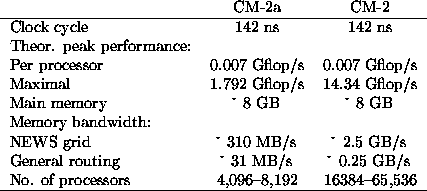
Machine type: Processor array.
Models: CM-2a, CM-2.
Operating system: Internal OS tranparent to the user, Unix on front-end
system.
Compilers: CM Fortran (subset of Fortran 90), C*, *Lisp (Lisp with
extensions).
System parameters:

Performance:

As the CM-200 the CM-2 is of the SIMD processor array type. The general processing elements are or the simple bit serial type. Of these 16 are clustered with a full crossbar connection between PEs in a cluster. The clusters (processors chips in Thinking Machines' terminology) are connected in a hypercube structure which, depending on the model has a dimension of 8 for a 4,096 PE machine to 12 in a 65,536 PE machine. Each processor chip is complemented by a router chip for routing data. The router chip also has limited computational abilities.
Although the basic PEs are of the 1-bit serial type, each two 16 PE clusters are enhanced by a Weitek floating-point processor with a speed of 7 Mflop/s.
For regular data movements the so-called NEWS (North, East, South, West) grid is used. The NEWS grid is a reconfiguration pattern of the hypercube. Because of the simple routing pattern without data collisions, transfer on the NEWS grid is much faster than with the general routing scheme.
Unlike other systems of the SIMD processor array type, the CM-2 has no control processor but has instructions that cannot be executed by the CM-2 performed by the front-end system via a front-end interface board (FEBI). More than one FEBI can be fitted into the front-end for the larger CM-2 models (4 for the 32K and 64K machines and 2 for the 16K machines). Via a corresponding number of so-called sequencers in the CM-2, 4 or 2 users can be accomodated at the same time.